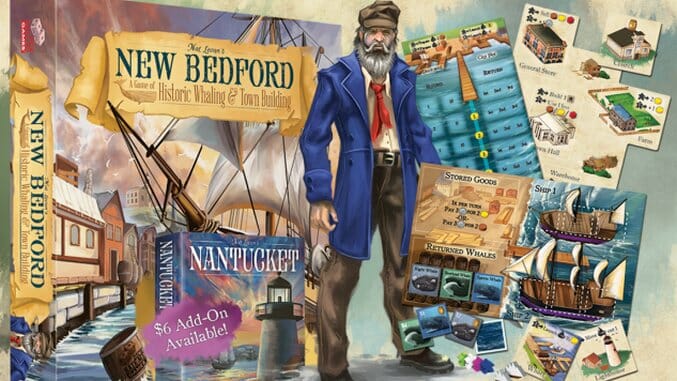“Cute” Isn’t an Insult For the Great Boardgame New Bedford

New Bedford, named for the Massachusetts town of that name, takes whaling as its theme. It creates a small narrative around the need to build and launch ships to catch whales, so players don’t just accumulate points for points’ sake, but spend most of the game doing things that garner points and help their whaling expeditions. The game manages to take the worker-placement mechanic and town-building theme found in more complex games like Caylus or Le Havre and simplify it enough that younger players can catch on to it. An entire game of twelve rounds runs well under an hour. It’s often a backhanded compliment—or subtle insult—to call a strategy boardgame “cute,” but New Bedford absolutely is that, between the artwork and the emphasis on a theme that plays small.
Set in the mid-1800s when New Bedford was booming, becoming one of the most important whaling ports in the world, this game starts out very simple, giving players just a few options for worker placement in the early turns until the town is built out by the players. Each player has only two meeples, and will place them each round, immediately taking the action from each space. The core town board has five options, where players can gather the game’s three resources (food and wood, required to launch whaling ships, and brick), build new buildings that get added to the town, or sell resources back for cash. There’s a second whaling board that has one space for players to build ships and another to launch them. These five spaces can be used by multiple players per round, but there’s a bonus for the player to choose each space first.
The two main paths to points in the game are through whaling ships and buildings. I don’t think it’s quite possible to ignore either of them and still compete, although it’s not necessary to balance the two. The base game comes with 20 buildings for players to construct with various combinations of brick, food and wood. Most of them create new action spaces—gaining $5 from the Bank, or 4 bricks from the Brickyard, or, what I think is the most valuable one, the Dry Dock, which allows players to build a ship and launch it in one fell swoop. Four of the buildings provide victory point bonuses at game-end, much as you’d find in Puerto Rico or the two games I mentioned above.
The town board has an irregular shape so that there are four edges to it where each player places the buildings s/he has built. Any player can use one of your buildings by paying you $1, after which no one can use it for the rest of the round. Regular buildings are worth a point apiece at game end, but the steady income you get from the buildings can prove critical.
Whaling ships require a lot of resource management, and the mechanic is the clear heart of New Bedford. You build a ship for just one or two wood tokens, but you launch it with food (the provisions for the crew). The more food you supply, up to six tokens, the farther from shore the ship goes, which confers two benefits on you: the farthest ship gets first claim on the whale tokens drawn from the bag in that round, and each ship stays out at sea for as many rounds as its provisions permit (equal to the number of food tokens).
The whale tokens are drawn each round from a bag that contains four token types: sperm whales, the rarest and most valuable (one per player); broad whales; right whales; and empty sea tokens. In a round, one whale token is drawn per ship at sea, plus one more; each player with a ship out chooses which whale token to take, from the ship farthest from shore to the nearest; any unclaimed tokens are returned to the bag. Thus as the game progresses the odds of drawing empty sea tokens increases, so getting a ship out early is useful.
-

-

-

-

-

-

-

-

-

-

-

-

-

-

-

-

-

-

-

-

-

-

-

-

-

-

-

-

-

-

-

-

-

-

-

-

-

-

-

-









































